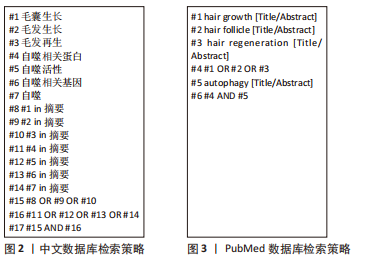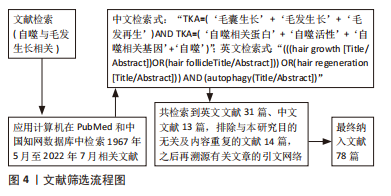[1] 吴大兴,杨松标,钮正祥,等.斑秃患者与雄激素性脱发患者心理状况比较[J].预防医学,2017,29(5):511-513+517.
[2] 邱学军,龙俊茹,韩亮,等.斑秃非手术治疗法的研究现状与展望[J].激光生物学报,2022,31(3):208-214.
[3] CLAUDE-TAUPIN A, DUPONT N, CODOGNO P. Autophagy and the primary cilium in cell metabolism: What’s upstream? Front Cell Dev Biol. 2022;10:1046248.
[4] FERNáNDEZ ÁF, SEBTI S, WEI Y, et al. Disruption of the beclin 1-BCL2 autophagy regulatory complex promotes longevity in mice. Nature. 2018;558(7708):136-140.
[5] SAKAMAKI JI, RYAN KM. Autophagy Determines the Path on the TRAIL to Death. Dev Cell. 2016;37(4):291-293.
[6] PATTINGRE S, TASSA A, QU X, et al. Bcl-2 antiapoptotic proteins inhibit Beclin 1-dependent autophagy. Cell. 2005;122(6):927-939.
[7] 郭雪峰,包鹏甲,常永芳,等.哺乳动物毛囊发育及调控研究进展[J].中国畜牧兽医,2019,46(2):387-394.
[8] ZHAO R, YIHAN W, ZHAO Y, et al. Hair follicle regional specificity in different parts of bay Mongolian horse by histology and transcriptional profiling. BMC Genomics. 2020;21(1):651.
[9] 王缓,王兴群,邹希,等.宣肺视角下脱发炎性因子的表达改变[J].中国中医药现代远程教育,2022,20(12):202-205.
[10] 贾琪,刘艳光,罗新惠,等.毛囊干细胞主要信号分子调控研究进展[J].延边大学农学学报,2021,43(3):101-108.
[11] AL-NUAIMI Y, HARDMAN JA, BÍRÓ T, et al. A meeting of two chronobiological systems: circadian proteins Period1 and BMAL1 modulate the human hair cycle clock. J Invest Dermatol. 2014;134(3):610-619.
[12] DA ROCHA AL, PINTO AP, BEDO BLS, et al. Exercise alters the circadian rhythm of REV-ERB-α and downregulates autophagy-related genes in peripheral and central tissues. Sci Rep. 2022;12(1):20006.
[13] ZHANG J, CHEN R, WEN L, et al. Recent Progress in the Understanding of the Effect of Sympathetic Nerves on Hair Follicle Growth. Front Cell Dev Biol. 2021;9: 736738.
[14] WANG L, GUO LL, WANG LH, et al. Oxidative stress and substance P mediate psychological stress-induced autophagy and delay of hair growth in mice. Arch Dermatol Res. 2015;307(2):171-181.
[15] KAO WC, CHEN JC, LIU PC, et al. The Role of Autophagy in Osteoarthritic Cartilage. Biomolecules. 2022;12(10):1357.
[16] YOSHIMOTO T, MORINE Y, TAKASU C, et al. Blue light-emitting diodes induce autophagy in colon cancer cells by Opsin 3. Ann Gastroenterol Surg. 2018;2(2): 154-161.
[17] DIKIC I, ELAZAR Z. Mechanism and medical implications of mammalian autophagy. Nat Rev Mol Cell Biol. 2018;19(6):349-364.
[18] LEVINE B, KROEMER G. Biological Functions of Autophagy Genes: A Disease Perspective. Cell. 2019;176(1-2):11-42.
[19] YU JE, KIM Y, HONG DE, et al. Bee Venom Triggers Autophagy-Induced Apoptosis in Human Lung Cancer Cells via the mTOR Signaling Pathway. J Oncol. 2022;2022: 8916464.
[20] D’AMICO R, IMPELLIZZERI D, CORDARO M, et al. Complex Interplay between Autophagy and Oxidative Stress in the Development of Endometriosis. Antioxidants (Basel). 2022;11(12):2484.
[21] GEORGIOU M, YANG C, ATKINSON R, et al. Activation of autophagy reverses progressive and deleterious protein aggregation in PRPF31 patient-induced pluripotent stem cell-derived retinal pigment epithelium cells. Clin Transl Med. 2022;12(3):e759.
[22] GUO J, ZHU K, LI Z, et al. Adiponectin Protects Hypoxia/Reoxygenation-Induced Cardiomyocyte Injury by Suppressing Autophagy. J Immunol Res. 2022;2022:8433464.
[23] ABID R, GHAZANFAR S, FARID A, et al. Pharmacological Properties of 4’, 5, 7-Trihydroxyflavone (Apigenin) and Its Impact on Cell Signaling Pathways. Molecules. 2022;27(13):4304.
[24] VISHNIAKOVA KS, POPOV KV, VOROTELIAK EA, et al. Possible role of autophagy activation in the stimulation of regeneration. Mol Biol (Mosk). 2013;47(5):796-805.
[25] ASAKAWA K, TOYOSHIMA KE, TSUJI T. Functional Hair Follicle Regeneration by the Rearrangement of Stem Cells. Methods Mol Biol. 2017;1597:117-134.
[26] 王雷.氧化应激调节自噬参与C57BL/6小鼠慢性束缚应激诱导的毛囊生长期延迟[D].苏州:苏州大学,2013.
[27] CHAI M, JIANG M, VERGNES L, et al. Stimulation of Hair Growth by Small Molecules that Activate Autophagy. Cell Reports. 2019;27(12):3413-3421.
[28] PARODI C, HARDMAN JA, ALLAVENA G, et al. Autophagy is essential for maintaining the growth of a human (mini-)organ: Evidence from scalp hair follicle organ culture. PLoS Biology. 2018;16(3):e2002864.
[29] KLIONSKY DJ, ABDELMOHSEN K, ABE A, et al. Guidelines for the use and interpretation of assays for monitoring autophagy (3rd edition). Autophagy. 2016;12(1):1-222.
[30] LIU W, LI K, WANG G, et al. Impairment of autophagy may be associated with follicular miniaturization in androgenetic alopecia by inducing premature catagen. J Dermatol. 2021;48(3):289-300.
[31] FORTES C, MASTROENI S, MANNOORANPARAMPIL T, et al. Mediterranean diet: fresh herbs and fresh vegetables decrease the risk of Androgenetic Alopecia in males. Arch Dermatol Res. 2018;310(1):71-76.
[32] 陈倩. 羟基酪醇调控自噬缓解毛乳头细胞氧化应激损伤机制研究[D].广州:南方医科大学,2019.
[33] MARIÑO G, NISO-SANTANO M, BAEHRECKE EH, et al. Self-consumption: the interplay of autophagy and apoptosis. Nat Re Mol Cell Biol. 2014;15(2):81-94.
[34] NAM GH, JO KJ, PARK YS, et al. The peptide AC 2 isolated from Bacillus-treated Trapa japonica fruit extract rescues DHT (dihydrotestosterone)-treated human dermal papilla cells and mediates mTORC1 signaling for autophagy and apoptosis suppression. Sci Rep. 2019;9(1):16903.
[35] 方慧娟.丹参酮胶囊治疗雄激素性秃发模型小鼠的机制研究[D]. 北京:北京中医药大学,2021.
[36] GUND R, CHRISTIANO AM. Impaired autophagy promotes hair loss in the C3H/HeJ mouse model of alopecia areata. Autophagy. 2023;19(1):296-305.
[37] KANG S, LOUBOUTIN JP, DATTA P, et al. Loss of HtrA2/Omi activity in non-neuronal tissues of adult mice causes premature aging. Cell Death Differ. 2013;20(2):259-269.
[38] 林承列.针刺足三里穴位调节细胞自噬的研究[D].成都:成都中医药大学, 2017.
[39] 郑瑜,厉兰,胡绘平,等.自噬体及凋亡小体对新生小鼠支气管肺发育不良调控作用[J].河北医科大学学报,2020,41(11):1296-1300.
[40] YAMAGUCHI T, SUZUKI T, SATO T, et al. The CCR4-NOT deadenylase complex controls Atg7-dependent cell death and heart function. Sci Signal. 2018;11(516):eaan3638.
[41] FANG J, LERIT DA. Orb-dependent polyadenylation contributes to PLP expression and centrosome scaffold assembly. Development. 2022;149(13):dev200426.
[42] KLAPAN K, SIMON D, KARAULOV A, et al. Autophagy and Skin Diseases. Front Pharmacol. 2022;13:844756.
[43] OSANAI T, TANAKA M, IZUMIYAMA K, et al. Intracellular protons accelerate aging and switch on aging hallmarks in mice. J Cell Biochem. 2018;119(12):9825-9837.
[44] ZHANG CF, GRUBER F, NI C, et al. Suppression of autophagy dysregulates the antioxidant response and causes premature senescence of melanocytes. J Invest Dermatol. 2015;135(5):1348-1357.
[45] YOSHIHARA N, UENO T, TAKAGI A, et al. The significant role of autophagy in the granular layer in normal skin differentiation and hair growth. Arch Dermatol Res. 2015;307(2):159-169.
[46] YU DA, JANG S, OHN J, et al. Protective effect of autophagy in particulate matter-induced hair loss. J Dermatol Sci. 2022;107(3):173-176.
[47] PETUKHOVA L, PATEL AV, RIGO RK, et al. Integrative analysis of rare copy number variants and gene expression data in alopecia areata implicates an aetiological role for autophagy. Exp Dermatol. 2020;29(3):243-253.
[48] PETUKHOVA L, DUVIC M, HORDINSKY M, et al. Genome-wide association study in alopecia areata implicates both innate and adaptive immunity. Nature. 2010; 466(7302):113-117.
[49] HARDMAN JA, NICU C, TAI C, et al. Does dysfunctional autophagy contribute to immune privilege collapse and alopecia areata pathogenesis? J Dermatol Sci. 2020;100(1):75-78.
[50] XIE B, SUN J, SONG X. Hair Follicle Melanocytes Initiate Autoimmunity in Alopecia Areata: a Trigger Point. Clin Rev Allergy Immunol. 2022;63(3):417-430.
[51] ZHANG Y, ALEXANDER PB, WANG XF. TGF-β Family Signaling in the Control of Cell Proliferation and Survival. Cold Spring Harb Perspect Biol. 2017;9(4):a022145.
[52] BERTOLINI M, MCELWEE K, GILHAR A, et al. Hair follicle immune privilege and its collapse in alopecia areata. Exp Dermatol. 2020;29(8):703-725.
[53] 罗怡.SCD1通过抑制自噬对毛囊生长的调控作用及机制研究[D].重庆:重庆医科大学,2022.
[54] LOLLI F, PALLOTTI F, ROSSI A, et al. Androgenetic alopecia: a review. Endocrine. 2017;57(1):9-17.
[55] CHOI YK, KANG JI, HYUN JW, et al. Myristoleic Acid Promotes Anagen Signaling by Autophagy through Activating Wnt/β-Catenin and ERK Pathways in Dermal Papilla Cells. Biomol Ther (Seoul). 2021;29(2):211-219.
[56] ROBERTO VP, GAVAIA P, NUNES MJ, et al. Evidences for a New Role of miR-214 in Chondrogenesis. Sci Rep. 2018;8(1):3704.
[57] HWANG I, CHOI KA, PARK HS, et al. Neural Stem Cells Restore Hair Growth Through Activation of the Hair Follicle Niche. Cell Transplant. 2016;25(8):1439-1451.
[58] GONZÁLEZ-GARCíA A, GARRIDO A, CARRERA AC. Targeting PTEN Regulation by Post Translational Modifications. Cancers (Basel). 2022;14(22):5613.
[59] CAI B, ZHENG Y, YAN J, et al. BMP2-mediated PTEN enhancement promotes differentiation of hair follicle stem cells by inducing autophagy. Exp Cell Res. 2019;385(2):111647.
[60] SCHNEIDER MR, SCHMIDT-ULLRICH R, PAUS R. The hair follicle as a dynamic miniorgan. Curr Biol. 2009;19(3):R132-R142.
[61] BRAUN S, KRAMPERT M, BODÓ E, et al. Keratinocyte growth factor protects epidermis and hair follicles from cell death induced by UV irradiation, chemotherapeutic or cytotoxic agents. J Cell Sci. 2006;119(Pt 23):4841-4849.
[62] TOSTI A, PAZZAGLIA M. Drug reactions affecting hair: diagnosis. Dermatol Clin. 2007;25(2):223-231.
[63] LIANG DH, CHOI DS, ENSOR JE, et al. The autophagy inhibitor chloroquine targets cancer stem cells in triple negative breast cancer by inducing mitochondrial damage and impairing DNA break repair. Cancer Lett. 2016;376(2):249-258.
[64] 李婧.1,25(OH)_2D_3对C57BL/6小鼠毛发再生的作用研究[D].重庆:重庆医科大学,2019.
[65] 李婧,罗福玲,吴盛旺,等.3-甲基腺嘌呤通过抑制自噬促进小鼠毛囊再生的作用研究[J].中国药科大学学报,2019,50(4):468-474.
[66] CERVELLI M, AVERNA M, VERGANI L, et al. The Involvement of Polyamines Catabolism in the Crosstalk between Neurons and Astrocytes in Neurodegeneration. Biomedicines. 2022;10(7):1756.
[67] MARZANI B, PINTO D, SORBELLINI E, et al. New multi-targeting strategy in hair growth promotion: in vitro and in vivo studies. G Ital Dermatol Venereol. 2018;153(3):338-343.
[68] 张敏,黄蓉,段亚君,等.霍山石斛通过激活自噬和抑制凋亡促进脱发模型小鼠生发作用[J].合肥工业大学学报(自然科学版),2022,45(6):844-848.
[69] CHEN T, MA J, XU C, et al. Increased ATPase activity promotes heat-resistance, high-yield, and high-quality traits in rice by improving energy status. Front Plant Sci. 2022;13:1035027.
[70] MIYAZAWA H, SNAEBJORNSSON MT, PRIOR N, et al. Glycolytic flux-signaling controls mouse embryo mesoderm development. Elife. 2022;11:e83299.
[71] HU T, CHEN X, LU S, et al. Biological Role and Mechanism of Lipid Metabolism Reprogramming Related Gene ECHS1 in Cancer. Technol Cancer Res Treat. 2022;21:15330338221140655.
[72] XU Z, YE H, XIAO W, et al. Metformin Attenuates Inflammation and Fibrosis in Thyroid-Associated Ophthalmopathy. Int J Mol Sci. 2022;23(24):15508.
[73] VINCIGUERRA M, OLIER I, ORTEGA-MARTORELL S, et al. New use for an old drug: Metformin and atrial fibrillation. Cell Rep Med. 2022;3(12):100875.
[74] OU HT, CHEN PC, WU MH, et al. Metformin improved health-related quality of life in ethnic Chinese women with polycystic ovary syndrome. Health Qual Life Outcomes. 2016;14(1):119.
[75] SHAHEBRAHIMI K, JALILIAN N, BAZGIR N, et al. Comparison clinical and metabolic effects of metformin and pioglitazone in polycystic ovary syndrome. Indian J Endocrinol Metab. 2016;20(6):805-809.
[76] LIN RL, GARIBYAN L, KIMBALL AB, et al. Systemic causes of hair loss. Ann Med. 2016;48(6):393-402.
[77] TRIPATHI M, SINGH BK, LIEHN EA, et al. Caffeine prevents restenosis and inhibits vascular smooth muscle cell proliferation through the induction of autophagy. Autophagy. 2022;18(9):2150-2160.
[78] FISCHER TW, HERCZEG-LISZTES E, FUNK W, et al. Differential effects of caffeine on hair shaft elongation, matrix and outer root sheath keratinocyte proliferation, and transforming growth factor-β2/insulin-like growth factor-1-mediated regulation of the hair cycle in male and female human hair follicles in vitro. Br J Dermatol. 2014;171(5):1031-1043. |
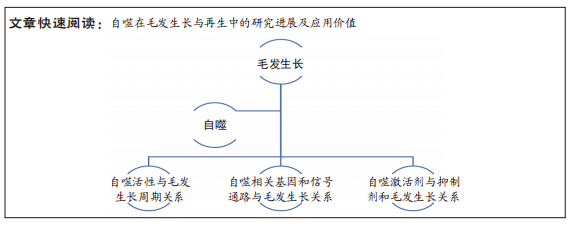
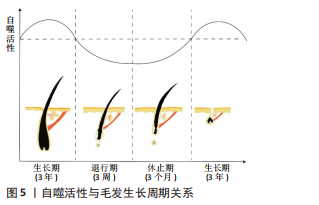
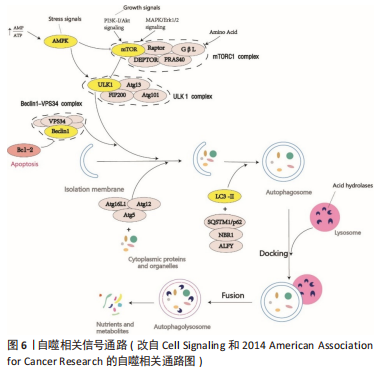
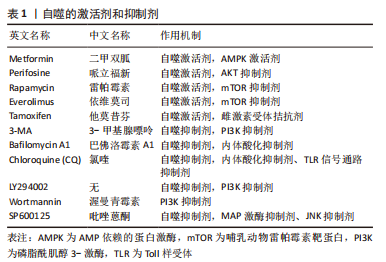
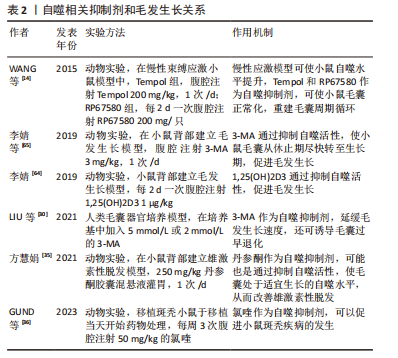
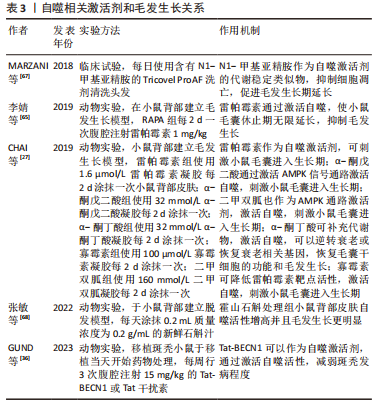

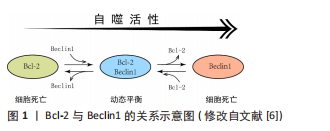 自噬作为机体的正常生理活动,在营养缺乏、能量代谢异常、缺血缺氧和感染等诱发因素下,调控体内各个系统及器官维持稳态。近年来多篇文章研究了自噬与毛发生长的关系,但是尚缺乏总结该方面的文章,为此作者检索并汇总相关文献,着重对自噬在细胞和毛发生长中的作用机制以及其在临床上的应用进行综述,为通过改变自噬活性治疗病理性脱发提供理论依据。
自噬作为机体的正常生理活动,在营养缺乏、能量代谢异常、缺血缺氧和感染等诱发因素下,调控体内各个系统及器官维持稳态。近年来多篇文章研究了自噬与毛发生长的关系,但是尚缺乏总结该方面的文章,为此作者检索并汇总相关文献,着重对自噬在细胞和毛发生长中的作用机制以及其在临床上的应用进行综述,为通过改变自噬活性治疗病理性脱发提供理论依据。
